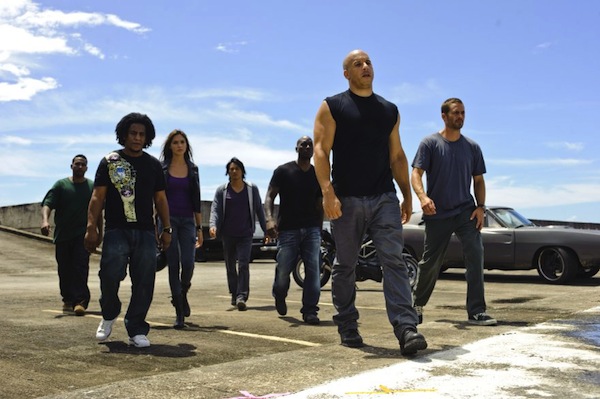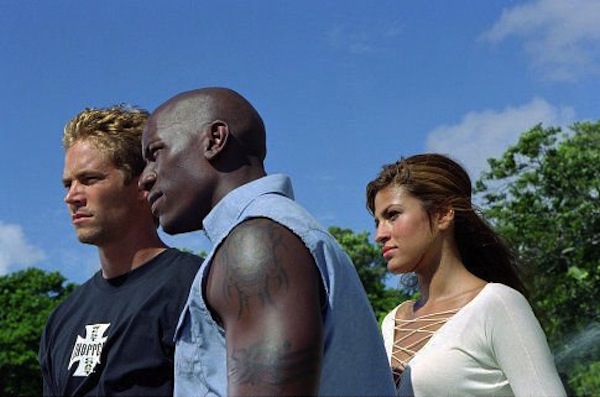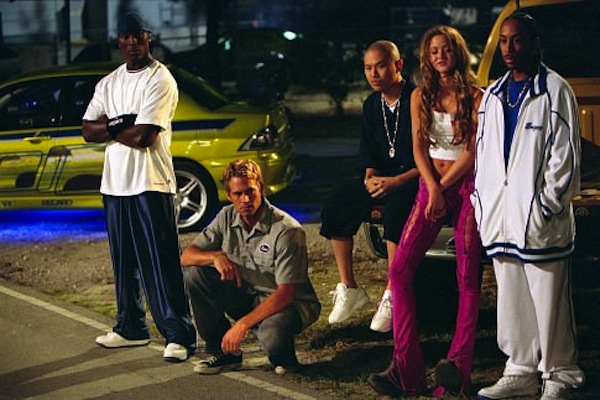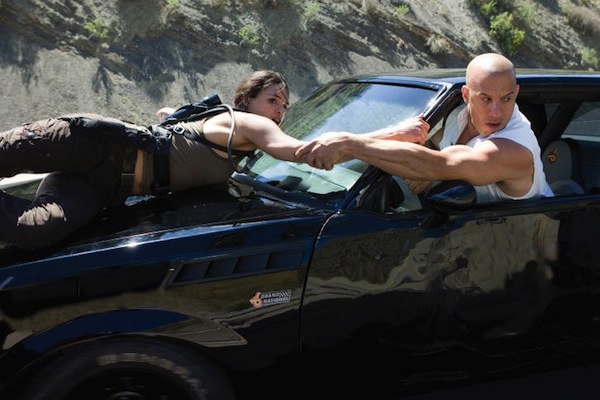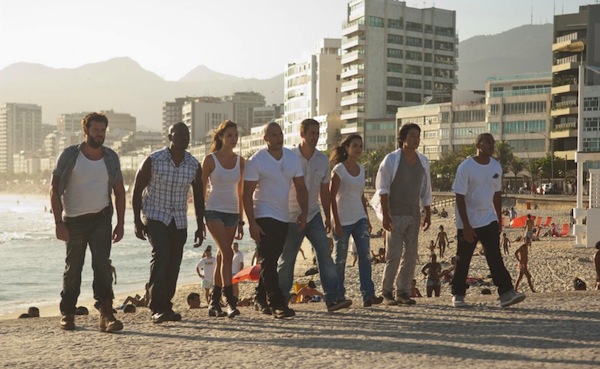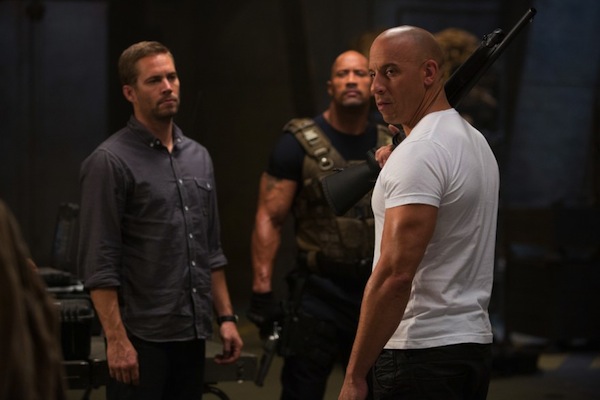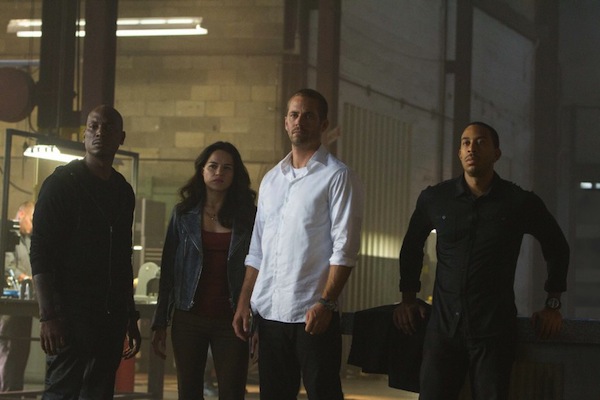“Ride or die.” Those words only appear a few times in the franchise – most famously out of Vin Diesel’s gravelly baritone in Fast & Furious 6 – but they have become the personal motto for how this franchise has continued, grown, succeeded and become greater with each film. Today, Furious 7, the latest in the series will be released, and it’s a mark of achievement not only that they’ve made it to seven films, but that it only feels exciting for a seventh film about criminals racing cars to be released. The Fast and the Furious franchise is unlike any franchise out there right now, as it has evolved from perfectly adequate popcorn films about criminals racing cars to superb and exhilarating blockbuster action films. No other franchise can say that they only began to hit their creative stride with the fifth film. To understand how we arrived at this point though, you need to go back to the beginning. This transformation didn’t happen overnight, it happened incrementally through trial and error. Essentially, a ride or die mentality.
Back in 2001, Universal Pictures released a modestly put together popcorn film titled The Fast and the Furious by Hollywood grunt-for-hire director Rob Cohen, exactly the run of the mill recycled storytelling that Hollywood is known for. The film was reportedly based on an article about the world of underground street racing in Los Angeles, but honestly this film is a beat-for-beat remake of Point Break – but with cars. Undercover officer Brian O’Connor (Paul Walker) infiltrates a group of underground street racers led by Dominic Toretto (Vin Diesel) who are suspected of multiple armed robberies.
To watch the film now is similar to looking at an old yearbook. Everyone has changed and grown up, just as you have. You’re looking at old friends before all the success, struggle and evolution of growing up. Today, most of the cast in this franchise are household names, but back then they were largely unknowns. Vin Diesel was just starting to make a name for himself after breaking out in Pitch Black following memorable turns in Saving Private Ryan and The Iron Giant. Paul Walker had a few positive turns in Varsity Blues, Pleasantville and The Fast and the Furious director Rob Cohen’s previous film The Skulls, but this film would be the first that you would remember him as Paul Walker rather than “that handsome fella”. Jordana Brewster had been spending all her time on As the World Turns previous to this film, and Michelle Rodriguez had more indie cred than action cred before this film after a breakout role in Girlfight the previous year.
This film lives up to its title. Everything about it is as fast, loud and gratuitous as it possibly can be. Within the first 2 minutes a car is driving at high speeds directly under a semi truck. Within the first 10 a fistfight has broken out simply because the script called for it. When Dom breaks up the fight, Brian protests “Hey man he was in my face.” Dom gives him a blank look and toughly says, “I’m in your face.” That’s Vin Diesel’s first line in the franchise. At minute 13 Michelle Rodriguez’s Letty interrupts the flirtations of some girls towards Dom with a meow then saying, “I smell……*sniffs the air vigorously*…..skanks. You girls just pack it up before I leave treadmarks on your face.” This is the first 15 minutes of the film, and there is still 90 more to go.
What’s interesting is that even back then the themes revolving around the importance of the family that you create were integral to the franchise. The word “family” is used repeatedly to describe Dom’s group, and Brian envies the bond between the criminals he’s supposed to be infiltrating. At the end of the film Brian chooses his new family, letting Dom get away at the end at the risk of his career.
The film grossed $144 million domestically – and $207 million worldwide – off of a modest $38 million budget, so naturally Universal Pictures wanted more. Ride or die. Rob Cohen and Vin Diesel opted not to return for the sequel so they could try and jumpstart another Vin franchise in xXx, so Paul Walker ended up being the only original cast member to return. The vacant director’s spot was filled – through circumstances I honestly don’t know – by none other than Boyz n the Hood director John Singleton. There is a lot to admire about 2 Fast 2 Furious (besides having the greatest title for a sequel ever), but it says a lot about the progressive quality of these films when I tell you that an Oscar nominated director didn’t even make the 3rd best film in the franchise.
2 Fast 2 Furious fills in the blank spaces between the end of the first and where this story picks up – though there is a special “turbo-charged edition” prologue in the home release of the film that holds your hand and walks you through it (with a bonus pre-Friday Night Lights Minka Kelly) – where Brian has settled in Miami as a street racer known as “Bullitt” (high-five to the writers) after running from the feds. After getting caught, his former FBI boss from the first film offers him a deal: help bring down drug lord Carter Verone (Cole Hauser) and his criminal record gets wiped clean.
Since it only had one character from the franchise return, this film had to find a way to lose as many possible links between the first film and this one. This meant a new team in Roman Pearce (Tyrese Gibson), Tej (Ludacris – sorry, Chris Bridges) and Suki (Devon Aoki), a new love interest in Customs agent Monica Fuentes (Eva Mendes) – as little connection as possible with the first one without ignoring what happened in that film. They had to alienate themselves from the first film without alienating themselves from the fanbase.
To its credit, this film does best the original in more than one category. There is a real sense of excitement in the coherent and well-planned shooting of the race scenes by Singleton, and this film features the franchise’s first truly great villain in Carter Verone with supremely underappreciated actor Cole Hauser milking the role for all the psychotic sleaze he can.
The biggest criticism this film always faces is that it’s stupid. This film is indeed stupid, but gloriously so. This movie is actually kind of amazing in its own ridiculous ways. All the insanity and completely unbelievable stakes that you would see in later films (see: bringing a tank to a car fight, sky diving cars) began here as John Singleton directs the film like a nos-fueled episode of Miami Vice. Tyrese Gibson plays the comedic foil to Paul Walker, the two at each others throats just as much as they have each others backs. They constantly refer to each other with “bruh” and “cuz” in a completely unnatural tone. If the two weren’t criminals this could easily be a buddy cop film. Roger Ebert lovingly said of the film, “It doesn’t have a brain in its head, but it’s made with skill and style and, boy, is it fast and furious.”
While the film did well at the box office, it unfortunately didn’t light it up the way that Universal Pictures was hoping it would. After doubling the budget to $76 million, the film did worse domestically than its predecessor with just $127 million, but did slightly better than the first did worldwide with $236 million. It’s strange that that much money is considered bad news, but hey, this is also a business, and at the end of the day they didn’t make the type of money they were hoping to. This lead to the franchise’s first potential death, but after some time it would find its way back to theaters. Ride or die, after all.
Neal H. Moritz, who has produced all the films in the franchise realized he had to take a step back with these films and bring it back down to earth. You couldn’t go 3 Fast 3 Furious after the middling returns of the second film. What made it tougher was that the original cast including Paul Walker had moved on to other things. They essentially needed to give the franchise a soft reboot. It was time for a new director, new writer and new cast.
Enter Justin Lin. Justin Lin had never worked in Hollywood before, had never directed an action film, let alone a car chase. He was best known for the independent film Better Luck Tomorrow that debuted at Sundance. Most directors don’t fancy breaking into Hollywood by directing a third film in someone else’s franchise, but Lin was genuinely excited to get to tell his own story in this universe, having been a big fan of the previous two films (this kind of explains why he’s happy to helm the upcoming Star Trek 3). He was perfect for the job. Chris Morgan had only one screenplay made before Tokyo Drift, and it was the entertaining last-of-the-90s-action-film thriller Cellular. Cellular moved at a quick pace that managed to keep fresh during its runtime with minimalist action setpieces (Sidenote: Cellular is amazing). He was perfect for the job.
This new plot followed high school student and street racer Sean Boswell (Lucas Black) moves to Tokyo to live with his military father in order to avoid a jail sentence. Upon arriving, he gets involved in the local underground drift racing circuit and makes enemies with its champion. And just for the record this film has Sonny Chiba playing a Yakuza boss, so that’s amazing. This film also features Han (played by Lin’s Better Luck Tomorrow actor Sung Kang) – who dies in this film after a collision in a street race – who is secretly the most important character in the franchise. He’s never the lead, but he is integral to the timeline of these films. The three films that followed Tokyo Drift all have one chief goal, and that is to get Han to Tokyo.
There is a bare-bones gritty type of shooting that Lin excitingly shoots the action and racing with, but manages to not lose focus of his characters and story. Believe it or not, contrary to popular opinion, this was actually the best film in the series when it was released. The Fast and the Furious: Tokyo Drift is often considered the worst film in the franchise, which is completely false and unfair. If anything, this is actually the most important film in the franchise. This film spawned what would become the strangest rebirth of a franchise I’ve ever seen – making 3 prequels to this film. You take this film out, you have no connection between any of the other films and Furious 7 – Han and his death. Although this film bombed at the box office, its failure was the catalyst in future successes. Without the failure of this film, you wouldn’t have Fast Five, Fast & Furious 6 and Furious 7. Ride or die.
The only direct connection to the previous films comes at the end when Vin Diesel’s Dominic Toretto shows up wanting to race Sean, telling him he was a friend of Han’s. While this appearance managed to reignite interest from core fans, the real reason Diesel did it was that Universal would give him the rights to the Riddick franchise in exchange for a no pay appearance. Diesel’s reasons for returning were admirably economic, but from the brief time that he and Lin spent together on set, a creative relationship was born that would shape the franchise to come.
Somehow the film got an $85 million budget despite no star power, just strictly off of brand name alone. Because of the sharp deviation from the first two films in terms of characters and setting, this film was likely never going to be the same sort of hit that the first two were. But that doesn’t mean it deserved to bomb the way it did. The film only made $62 million domestically, already putting it $20+ million under its budget. The foreign box office take of $95 million certainly helped, bringing up the total worldwide take to $157 million – in fact the foreign box office stayed steady in line with the foreign takes from the previous two films. Foreign box office numbers weren’t quite the same juggernaut for productions that they are today, but even back then this franchise could see the value of that profit.
The franchise had now reached its second potential death in three films. If there was ever a time for this franchise to truly bite the dust and sink into anonymity for 15-20 years before Hollywood tried to squeeze some more cash out of it with a reboot (and you can argue that this is how we got Fast & Furious to some extent) then that time was now. But remember, ride or die.
Somehow the team behind this franchise managed to turn it all around, the end result which was to create three prequels to this film that would take place between 2 Fast 2 Furious and Tokyo Drift, bring back the core original cast members, and pepper in Han for continuity. And the amazing thing is that it all worked. Fast Five and Fast & Furious 6 standing as the best and most profitable films in the franchise with Furious 7 certain to join the club. Basically, at some point somebody had the grand idea for this semi-reboot and pitched it. I imagine it went something like this:
A group of producers sit in a Universal Pictures office room, covered with dozens of posters for The Fast and the Furious franchise. None of the producers look happy, there is a stench of disappointment in the air.
Suddenly the office door kicks open and another producer bursts in, waving the air with one hand and wiping the cocaine residue off his nose with the other.
“Guys! Guys!” He exclaims. “I got it! I know how we can save this. I know Tokyo Drift bombed but I know how we can save this! We just need to make three prequels to this film with the original cast all leading up to Han’s death, and it’ll fix it!”
The other producers take this in. One speaks up after a moment.“…..Good God Jimmy, you’ve done it again.”
The room breaks into applause.
Ride or die. It was time to go back to the well, and luckily this time they got the original core ensemble to return – Paul Walker, Vin Diesel, Jordana Brewster and Michelle Rodriguez all returned to their roles from The Fast and the Furious. This was the big selling point on this film, and they cut the fat out of the title with the simple Fast & Furious. What’s really interesting is that Justin Lin and Chris Morgan were brought back as the director and writer to course-correct the franchise that they had basically wrecked in the first place. Box office numbers be damned, Moritz and company knew that these two were there guys and were going to back them no matter what. It’s a type of loyalty that you typically don’t see within the studio system, as any other studio would have cleaned house from top to bottom for a move like this.
Right from the opening scene, Fast & Furious feels renewed and exciting as Dom, Letty and Han – Han showing up was a pretty big surprise, as most didn’t know they were watching a prequel for an installment they didn’t see – rob a gas truck in the Dominican Republic. It immediately feels big in a way that makes you wish you were watching it in IMAX, which the future films would harness even further. This film was all about bringing it back to basics. Brian was a lawman again, this time as an FBI agent, while Dom and Letty were back to pulling robberies and racing fast cars. The location was brought back to Los Angeles, just as in the first film. There were dozens of callbacks to the original film, with Brian and Dom arguing about who would win in a race and Dom waxing on the importance of family. And once again, Brian chooses his new family at the end when he assists Mia in breaking Dom out of a prison transport bus.
The plot kicks off when Letty is murdered by the order of drug trafficker Arturo Braga (John Ortiz), and Dom returns home to track him down for revenge. Brian is working Braga’s case for the FBI and the two cross paths and eventually team up as they infiltrate Braga’s organization. This film also has attempt #1 to get Han to Tokyo. Early in the film Dom tells him to make his own life now, and asks where he wants to go. Han says, “I heard they’re doing some crazy shit in Tokyo.” Boom. Paycheck.
This is when the series started becoming action films rather than just racing films. The opening foot chase with Brian chasing down a suspect could have come from a Bourne film, and the stakes of the car chases feel bigger and grander than previous installments. Vin Diesel also gets some great action one-liners in this film, helping his ascension to a true action star. After Braga receives a blessing from a priest, Dom shows up with a shotgun pointed at him and says, “You ain’t forgiven.” After killing henchman Fenix by ramming him with his car, Dom just remarks, “Pussy.” Dominic just became an action hero with this film.
This soft reboot gamble paid off for the creative team behind the film, as the film brought in $70 million in its opening weekend, which was more than Tokyo Drift’s total domestic take. The film would end up making $155 million domestically and $363 million combined worldwide, all against a budget of $85 million. The final worldwide take for this film was $100+ million more than any previous film in the franchise. The Fast and the Furious films were officially a cash cow again, and Universal wanted more.
I’ve had nothing but generally good-great things to say about the first four films in this franchise, so brace yourself when I tell you that Fast Five is where this series really gets going. These days the way to run a franchise is to Avengers-style it, where you have several movies leading up to a teamup film all in the same shared cinematic universe. You think that that was revolutionary and brilliant? It has nothing on Fast Five. If I’m running a studio I’m pulling a Fast Five with every franchise I possibly can. They essentially doubled down on their “bring everyone back from the original” tactic of Fast & Furious. Basically how it works is that anybody who has ever been in a Fast & Furious movie before has the opportunity to return. Core originals in Paul Walker, Vin Diesel and Jordana Brewster? Check. 2 Fast 2 Furious gang with Tyrese Gibson as Roman Pearce and Ludacris (sorry, Chris Bridges) as Tej? Check. Sung Kang as the somehow still alive Han (this film is also a prequel)? Check. The guy that played Vince (I’m sorry I don’t know your name, nobody does) in the first film? Check. Leo and Rico from Fast & Furious? Check. Gal Gadot returning as Gisele from Fast & Furious? Check. The only thing better than being alive at this time was being alive and having been in a Fast & Furious movie, because you were being brought back for the best film in the franchise and a massive payday.
The plot of this one finds Dom, Brian and Mia hiding out in Rio de Janeiro and decide to pull off one last heist of $100 million to disappear and buy their freedom. They call in every connection they have, hence literally every cast member from every Fast & Furious film coming back, and set their sights on Rio crimelord Hernan Reyes, who runs everything in the city including the police. True story, when I was learning Portuguese in college and my professor asked if any of us had seen any Brazilian films, I asked if Fast Five counted. For what it’s worth, the Portuguese in this film is accurate – or at least it does to me, a dude who studied it in college and went to Rio and probably isn’t the person who can make the call on that sort of thing.
There is a definitive break between these films as a racing series and these films as action movies, and it happens in one particular scene in Fast Five (or rather the lack of one particular scene). At one point Brian and Dom have to go win some cars fast (and furious) enough to pull off the heist. They go to the local underground street racing circuit (everywhere has one apparently) and race for cars. We’ve seen this dozens of times before, Dom and Brian are gonna win an awesome race by pulling some sweet moves out of their asses, right? Wrong. Just before the race starts, Lin cuts to the next scene with them arriving at their hideout, the cars in tow. By cutting out this franchise-standard race scene, Lin communicates immediately that this is a franchise no longer limited to just driving fast. This wasn’t a racing film, this was a heist actioner.
The other big factor in the renewed success that this film had for the franchise was casting The Rock as U.S. Security Services agent Luke Hobbs. I’ve written at length before about how The Rock will always bring home moneybags and reenergize your franchise if he’s in a franchise ensemble, and that reputation started with Fast Five. The Rock has the greatest introduction of any character in the series. He and his epic goatee exit a plane as he issues urgent orders to his men. A police chief asks him if he needs anything, he says he needs two things. After issuing his first request, the following exchange happens. “What’s the second thing?” The camera dollies in on The Rock. “Stay the fuck out of my way.”
Other great exchanges:
– “Good news and bad news.” Says a team member. The Rock is quick to answer, “You know I like my dessert first.” He tells him the good news, The Rock responds asking for the bad news with “Give me the damn veggies.”
– “If he goes to the john, I wanna know how many times he shakes it.”
Wesley Morris called these films “the most progressive force in American Cinema” and he’s completely right. You won’t find another franchise that has as racially diverse a cast as these films, but most importantly doesn’t treat any of its characters as set decoration. This was a part of each film in the franchise, but didn’t reach its full potential until Fast Five. Each returning character finds new life in their group roles. Tyrese Gibson especially settles well into playing Roman as the bumbling idiot of the group. At one Roman starts taking out cop cars with his own cop car and whips out every possible one-liner he can. “Good afternoon officer!” and “License and registration please!”
The scale and scope of the film continues to grow from Fast & Furious, with this film featuring a jaw-dropping chase where Dom and Brian drag a bank vault through Rio while literally every cop in the city chases after them. Half the city gets demolished, and dozens upon dozens of dirty cops are killed, yet somehow the scene is simply thrilling enough to not make you think about those consequences. They would also make a course correction on this mentality in Fast & Furious 6 as Dom instructs Roman to distract the tank from the civilians among other efforts to preserve all life in the film – but seriously it’s a mark of achievement that they could cause this much destruction in a film and not have you pause for a second to contemplate the lack of responsibility of it.There is a scene in Fast Five where Paul Walker has to escape from a car that’s on fire. Back then it was an exciting thing to watch, now it’s very unsettling. And there’s something great in watching how Dom and Brian, when they drive a car off a cliff, just calmly jump out of the vehicle knowing that they are going to be fine.
The fight scene between Vin Diesel and The Rock is seriously amazing, I would put it in the top 5 greatest one-on-one fight scenes of all time any day. These two really beat the shit out of each other, each move and moment more exciting and brutal than the last. The Rock rips off his bulletproof vest in one motion mid-fight just for effect. They throw each other through walls, making use of the entire space as they slam each other into any object within reach. As soon as Hobbs rams into Dom’s car and totals it, you know shit is about to go down and the scene delivers on it.
The running theme about family hits hardest in this film. Dom is only able to beat Hobbs in the fight because he achieves the power of fighting for family. Brian and Dom talk about the responsibility and importance of being a father after they find out Mia is pregnant. You always have room for family, and you always have forgiveness for them are values that are lived by these characters.
This film had the highest opening weekend, domestic gross and worldwide gross – basically every measure of monetary gain – in the franchise, scoring a whopping $629 million worldwide against a $125 million budget. This film made more money than a combination of any two previous films in the franchise. The film ends, and you get the feeling they could have ended the series there, patted themselves on the back for ending the series on the highest note and gone home. But no, this series was never about calling it quits after the big score, this series was about one thing: Ride or die.
The scene after the end credits finds Hobbs in his office late at night, when lo and behold, Eva Mendes shows up as her character customs agent Monica Fuentes from 2 Fast 2 Furious (EVERYTHING IS CONNECTED) and slaps a file on his desk. “You need to look at that.”, she says. She details a group of drivers that hijacked a convoy in Berlin, which leads to a photo of Letty. “You believe in ghosts?”, she asks. BOOM. PAYCHECK. And that is how we got to Fast & Furious 6.
The whole gang was back this time again – minus Leo and Rico (because I guess they both had better things to do?), plus Fast & Furious villain Arturo Braga and pathetic FBI Agent Stasiak played by all-time 6th man utility MVP Shea Whigham – with Lin and Morgan once again as director and writer. The plot kicks off when Hobbs gets Dom and his crew to help him catch Owen Shaw in exchange for full pardons of their crimes and the opportunity to get the newly resurrected/amnesiac Letty (nobody just dies in these films, there is always a gloriously ridiculous ulterior motive) back into the family fold.
The series hits a certain groove with Fast & Furious 6. The absolutely unbelievable insanity of 2 Fast 2 Furious was fully realized here, with the same ambition, focus and spectacle that Lin had brought in Fast Five. This franchise had fully evolved into a successful action spectacle under Lin and Morgan.
Luke Evans plays perhaps the best villain in the franchise in Owen Shaw. He’s always 6 steps ahead of the team and is a very legitimate threat to them the whole way through. He has a steely demeanor that masks sociopathy just beneath, and his mantra about control and having a code bleeds into his mannerisms and posture. He repeatedly mentions his older brother and the harsh life lessons he taught him, and Evans shows that those lessons are more scarring than nurturing.
The action in this film is the biggest, boldest, most ridiculous and spectacularly constructed action in the series. The Rock literally jumps off a moving car and freefalls onto another moving car on a freeway below just to try and get Shaw. This is a film where Vin Diesel jumps out of a moving car in midair to catch Michelle Rodriguez and then breaks their fall by slamming his back into a car windshield. He doesn’t even flinch at it. When she later asks him about how he knew there would be car there to break their fall, he simply replies, “I didn’t. Some things you just have to take on faith.” I was legitimately surprised when Gina Carano’s Riley turned out to be evil. When she goes with Owen at the end, my friend and I totally gasped. We felt like idiots to be played like that so easily, but sometimes you’re glad to be taken for a fool. This is a film where a tank shows up on a freeway and starts obliterating everything in sight, and somehow you don’t question the plausibility of it – the sequence is so expertly and exhilaratingly constructed that you’re happy to throw all logic out the window. The fight scenes are hard-hitting and exciting, the fight between Michelle Rodriguez and Gina Carano is brutal, and watching Vin Diesel pick up that huge hulk-looking guy so that The Rock can pile-drive him is a serious highlight of my life.
Even as the action and stakes get turned up to eleven in this film, it still doesn’t lose sight of its core themes of family. As Mia says near the beginning, “We’re family. You got a problem, we deal with together.” Dom later remarks “You don’t turn your back on family….even when they do.” Family is all that matters, ride or die.
After Gisele’s death, Han decides to head to Tokyo as that’s where she wanted to go with him. So here we are, finally back to where we started, with Han racing in Tokyo for his final time. Again, three films were made to get Han to Tokyo, and it totally succeeded. Only this time around, some things have changed. The car that hits Han? Guess who gets out of it. JASON STATHAM. When he exited the car my friend and I lost it. He looks at the cross necklace that his brother had on him and tosses it at Han, who is struggling to stay alive. He whips out his phone. “Dominic Toretto….you don’t know me…*car explodes in background*….but you’re about to.” Hangs up phone. Boom. Paycheck. The older brother that Ian kept mentioning throughout the film? That’s Deckard Shaw, played by all-time action hero Jason Statham.
So following that explosion – and a $789 million worldwide take against the $160 million budget, the highest grosser in the franchise – the next film in the franchise began construction full steam ahead. Only problem was that Universal wanted the film ready for the following Summer, so Justin Lin opted out of returning as he felt he couldn’t deliver the best film possible in that timeline. Fair enough, he resurrected the franchise that he killed, so he’s earned the right to make the film that he wants without compromises from the studio. There was a large vacancy with his absence though, as any Fast & Furious film without him at this point just wouldn’t feel right. They had lucked out in finding a director who was enthusiastic about taking over someone else’s franchise the third run in, but how could they possibly find someone with the same exuberance and skill to come in on the seventh run? Ride or die, that’s how.
Enter, all the way from left field, James Wan. James Wan is a modern master of horror, spawning the Saw franchise back in 2004, following it up with the promising Dead Silence, and helmed the first two Insidious films as well as delivering the horror classic The Conjuring. He hadn’t really done action before (Let’s hear some thoughts on Death Sentence), nor had he worked with a gigantic budget. He was perfect for the job.
Wan and Morgan went to work on the film with the franchise mainstays, bringing along Kurt Russell (!!!!), Tony Jaa, Ronda Rousey and Djimon Hounsou in new roles. Lucas Black would even be returning as Sean Boswell to bridge the connection between Tokyo Drift and all the other films. Even greater, they had Jason Statham as the bad guy. Jason Statham is an all-time action hero, but he’s also a terrific villain. The only time he’s been a villain before now? 2004’s Cellular, which if you’ve been paying attention was scripted by Chris Morgan (EVERYTHING IS CONNECTED). The plot would be a revenge one with Deckard coming after everyone, forcing Dom and the crew to team up once again with Hobbs in order to protect their family. Filming begin in the fall of 2013 with a release date set for July 11th, 2014. Everything was going smoothly.
Ride or die.
I remember November 30th, 2013 quite well. My friend and I were exiting the theater having just seen Jason Statham’s Homefront. We were in a great mood as Statham had kicked a lot of ass. I turned my phone back on as we got into the car, and suddenly received several text messages from friends and family informing me of Paul Walker’s death. He was involved in a car accident that afternoon where the car burst into flames. All the good feelings my friend and I were feeling immediately vanished.
It’s easy to eulogize somebody after they die, and make a bigger deal about their achievements than what is actually there, but there was no exaggerating the loss of Paul Walker. Yeah, he’d never given an Oscar worthy performance or made a film that changed the way we regard the human condition, but he was a familiar face in a lot of films that I liked and that counted for more. The first film in the franchise came out when I was roughly 9-10 years old. We would talk about how cool that film was on the playground. I had essentially known Paul Walker since the 4th grade. I had grown up with these films to a certain degree.
There was a time for mourning for everyone involved in the franchise. Filming was suspended as his family and the cast and crew grieved. With one of their core stars gone, how could they finish this film? Did they even have a film anymore? Ride or die. There was much debate about how to continue with this film and the franchise, and eventually it was thankfully decided that they wouldn’t kill Brian off, but would send his character off in a respectful and emotional manner. Filming resumed with Paul’s brothers Caleb and Cody acting as stand-ins to complete his remaining scenes. The release date shifted to today in order to give them the proper time to finish the film.
As of this writing, I have not seen Furious 7 yet. I have nothing but enthusiasm for it, and I’ve heard nothing but great things from those that caught it at SXSW. The trailers have been incredibly encouraging, with James Wan looking to have taken naturally to large action setpieces and gritty fights – the prospect of an action film with The Rock, Jason Statham and Vin Diesel has me giddy. The shot of The Rock slamming Jason Statham through a glass table literally makes me jump out of my seat and throw my back out. Also, sky diving cars. That’s incredible. However, Wan looks to have done this without losing the core emotion of the franchise: family. When I do see it, it may be the first film in the franchise to legitimately make me cry. When Paul Walker says farewell, the tears will come.
Universal naturally wants more films, and Vin Diesel has mentioned New York City as the setting for the next film. There are even rumblings that Justin Lin may return to the franchise after helming Star Trek 3. There aren’t easy answers and certainties for the future of this franchise, but it’s made it this far and has been great this far. One thing is for certain though, however they handle it, it will be done with one core principle: Ride or die.
— Dylan Griffin

